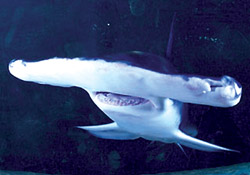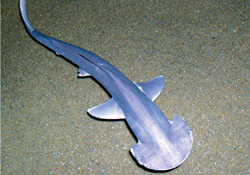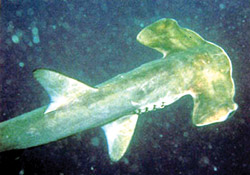|
Hammerheads:
Sharks with grotesque heads
Sharks....
does the very sound of the word fascinate you or send shivers down your
spine? It is no secret that sharks especially the great whites or killer
sharks are fish no one would want to encounter in the deep sea. Some of
you may be familiar with these awesome marine creatures and also aware
of the fact that there are many kinds of sharks in the oceans.
|

A hammerhead’s eyes and nostrils are located on either side of
the head. |
|

Great hammerhead |
Today we bring you some fascinating information about one of these
many varieties of sharks - the hammerhead sharks.
Known mostly for their weird looks than their size, hammerhead sharks
are found worldwide, in coastal areas, above the continental shelves in
warm, tropical waters. They are classified in the order
Carcharhiniformes, which means 'ground sharks' and are not as dangerous
as the kind of sharks featured in the popular movie series 'Jaws'. There
are nine species of hammerhead sharks and from among them, the great
hammerhead is considered dangerous, but not very aggressive.
What is distinctive about hammerhead sharks is their
grotesque(comically or repulisvely distorted), T-shaped heads which
resemble a flattened hammer. The head is indented at the centre of the
'hammer' and is almost rectangular in shape.
|

Scalloped hammerhead |
|

Four different shapes of heads. |
The eyes and nostrils are located at the tip of the projections on
either side of the head. The hammerheads have small mouths which are not
in proportion to their huge odd-looking heads.
Scientists are not sure as to why these sharks have such huge heads,
but there are many theories. One is that the manner in which their
sensory organs are placed help them in navigation and hunting of prey.
Whatever the purpose for such huge heads may be, it is a fact that
hammerhead sharks have a large range of senses.
All hammerheads can see red light, but they are known to be more
sensitive to the blue-green spectrum of vision as they are sensitive to
low light. Their vision is very sharp, but scientists say they could be
far sighted.
|

Bonnethead shark |
|

Small eyed hammerhead |
They have excellent hearing, and in fact can hear the entire range of
sounds humans can hear. Their speciality is the ability to hear even low
frequency sounds made by injured fish. Their ears have canals which are
used for not only balance, but also for motion detection. They can
easily detect an electrical signal of half a billionth of a volt.
Hammerheads are said to have 'swimming noses' because they have the
ability to detect chemicals like blood at concentrations as low as one
part per million. They usually swing their huge heads from side to side
like metal detectors to sample the water with their noses. When a
hammerhead is hunting prey, it will swim in a zig-zag pattern for miles
tracking the prey.
Hammerheads do a lot of bottom hunting; they skim the bottom of the
ocean in search of food which includes small sharks, shrimp, sting rays,
squid, crabs and bony fish.
Even though sting rays squirt venom at predators, hammerheads have a
defence against it and sting rays are a favourite food of their's. They
stir up the sand with the head and stay with their mouths open to catch
any prey that come up.
Hammerheads have dark brown to light grey dorsal surfaces that turn
olive as they fade into the underside, of their bodies, which are almost
off-white in colour. They have an anal fin and two dorsal fins without
spines. The five gills allow them to breathe by extracting oxygen from
water and then pushing the water over the slits. Did you know that they
have a spiral intestinal valve, like a spiral staircase, through which
food passes?
The food passes down this valve extremely slowly. Contrary to popular
belief, hammerheads cannot eat often, and as a result have a slow growth
rate. They grow up to about 11.5 feet generally.
|

Smooth hammerhead |
|

Winghead shark |
All hammerhead sharks form schools which can be 100 to 500
individuals. The reason why hammerheads form schools and other sharks
don't is however not clear yet. Anyway, it has been noted that when it
comes to feeding, the schools break up at night, and hunting is done
individually.
Would you believe that hammerheads are the only creatures in the
animal kingdom, besides humans, to acquire a tan from prolonged exposure
to sunlight? Scientists claim that tanning occurs when a hammerhead is
in shallow water or close to the surface for long periods of time.
Recent studies have revealed that when large groups of hammerheads
gather, they communicate by creating pressure waves; this is done by
thrashing their heads more sharply than usual in different degrees.
Scientists have identified about nine different methods of
communication.
Take a dive into the marine world and find out more about these
unusual fish who share this planet with us.
****
Fact file
* A shark is a fish with a skeleton made almost entirely of soft,
flexible cartilage.
* Hammerheads don't swim all day because then they'll burn up too
much energy.
As they have a liver filled with oil (which is lighter than water)
they give a buoyancy, and the fish seem like floating.
* They give birth to live litter which can be either 6 or 55 young.
Typically, they'll have 20 to 40 individuals, after a gestation period
of 11 months (carrying of young in womb). The young are left to fend for
themselves soon after birth.
* Great hammerheads are solitary fish and are generally considered
dangerous with many recorded attacks on humans. They are sometimes found
in waters less than one metre deep.
* The skin of hammerheads is used as leather, but they are not
considered endangered even though hunted for sport and for their skin.
* Apart from the great hammerhead, there are eight other species;
smooth hammerhead, scalloped hammerhead, bonnethead or shovelhead,
scalloped bonnethead, winghead shark, small eyed hammerhead and white
fin hammerhead. The smooth hammerhead is often confused with the great
hammerhead because both are very large.
* Great hammerheads are generally about 11.5 feet long, but one as
big as 20 feet has been recorded. Average weight is 500 pounds (230 kg).
They can however reach up to 1,000 pounds in weight.
* Located in their noses are sensory pores called ampullae of
Lorenzini which help them detect very weak electric fields, chemicals
and thermal changes in water.
* When catching sting rays, hammerheads first pin them down with
their heads and bite the wings off.
* Bonnetheads are small sharks and typically reach about 3.5 feet in
length. Greyish brown in colour, they form schools of about 20
individuals.
* Hammerheads are aggressive predators. They have triangular teeth,
with extremely serrated (saw-like) edges.
* The great hammerhead swims in warm water along the coastline and
migrate to cooler waters during the summer.
* The smooth hammerhead, the only one that appears in Canadian
waters, is characterised by a head that lacks a central indentation,
hence the name. |
